Happy 10th Book Birthday to 'Fika: The Art of the Swedish Coffee Break'
A conversation with Johanna Kindvall + two recipes to celebrate.
Hello friends,
Ten years ago today Fika: The Art of the Swedish Coffee Break landed on bookshelves.
Johanna Kindvall and I had pitched this book the old school way. I went to the local Kinko’s to make color printed copies of the proposal, stapled them all together, popped them in manila envelopes, and sent them out to assorted publishing companies. Just a decade later and this already feels incredibly antiquated.
Miraculously, the proposal eventually landed in front of the right eyes, and our editor Kaitlin Ketchum at Ten Speed Press said yes to working together. Unknown authors, without an agent, getting a deal from a proposal that ended up in the slush pile: this is a rarity in publishing.
Johanna and I went about putting together a book that we hoped would capture an element of Swedish culture that we both loved. We also managed to offer something that more and more people were craving: a moment to slow down.
Ten years later and the book still sells, still gets shared around. The fact that it’s still in print and Johanna and I still get royalty checks (nothing to live off of, but enough to buy some additional pastries and treats) is certainly worth celebrating.
For writers, books are like time capsules. The pages hold who we were when we wrote them. So much has changed in my life since the book was originally published (and the world too), but one thing is sure: fika is a constant.
Let’s celebrate!
In honor of Fika’s 10th birthday, Johanna and I sat down for a little chat, which I figured was kind of like you getting to sit down and have fika with us.
We also put together a couple of recipes for you. One is the quintessential cardamom buns from the book, but also with the option of a more celebratory filling. The other is a recipe that Johanna and I are both embarrassed that we forgot to include in the book, but it’s a favorite cake with almond and caramel topping called toscakaka.
After all, how can you celebrate a birthday without a little cake!?
-Anna
To anyone who is thinking, “I don’t own a copy of this book” today is a great day to remedy that situation.
ON FIKA: A CONVERSATION WITH ANNA BRONES + JOHANNA KINDVALL
Anna Brones: Well let's just start with how we feel about 10 years?
Johanna Kindvall: I don't understand where the time went. It felt like yesterday. But then, of course, lots of things have happened since. I still meet people that are excited about the book and occasionally I teach fika classes. Just a few weeks ago I got an email from somebody asking about one of the recipes in the book.
AB: I remember when we were working on the proposal, I went to Powells and looked to see what Scandinavian cookbooks were available. I think there were like three. There was Sju Sorters Kakors that had been translated. And then some lady from Norway. And that was about it. Now there's so many. So I think there has been a shift too, in what's available and what people are paying attention to. I still see news articles about fika as a productivity tip, which I think is funny.
JK: It is great. And there are now a few other fika books too
AB: But we are the original! At least I think so…
JK: Yes we are the original and I think the one that stands out.
AB: I was looking at it just because I pulled it out to use a recipe, and the cover is so classic. It’s modern. That's thanks to your artwork, and also Betsy, the designer, pairing the colors, and that that the main title matches with the coffee cup. It just looks so good. And it looks like it could have come out yesterday, which I think cannot be said for all cookbooks. Cookbooks date really quickly, in particular when they have photos. So I think that speaks to your illustrations. They hold their own over time.
JK: I agree, it’s both modern and classic, so it still works. It might be 10 years old, but it still sells!
AB: Because I always think about how books are a little bit of a time capsule for the person who wrote the book. That's us 10 years ago, that's not us today. So I am curious if there are any illustrations in there that you just can't stand looking at? Or, what would you change now, if you had to?
JK: They are ok, I'm quite pleased. [pointing to blackberry almond cake] That one I was never really happy with , and it's so funny, as that was the one that got published in The New York Times.
AB: Oh I know. It’s so funny that you pulled that recipe, because that recipe, my aunt Lotta makes it all the time. She calls it hastkaka (hasty cake) and you don't even have to mix it in a bowl, you just melt the butter in a saucepan and then mix everything in there. So it's a one-dish thing, which is not how it is in the [printed] recipe. I feel like when we were working on the book, we’re told not to say “oh you could do this, and then you can add these other things.” No, you have to have a complete and specific recipe. That recipe annoys me, because it has almond flavoring in it, which I really like, but then it’s called “almond cake,” but it's not actually an almond cake. [Laughs] It’s very misleading, I would change that.
JK: I still bake from the book.
AB: Yeah, same. I still use it. Mine's so dirty. [holds up book] look how dirty it is!
Do you have any distinct memories from working on it?
JK: Yes, actually, when I was doing the drawings, I was in a country cottage in Sweden for a month. I was there by myself and I remember the freezer was full of baked goods. It was September or October so I had the fire going and I was just drawing and having fika. It was super nice and cozy.
AB: You've written another cookbook since then, just the thought of writing another cookbook is unthinkable to me.
JK: Yes I wrote another cookbook. So did you, right?
AB: Yeah. It’s just that the process of doing a cookbook is so particular. I just don't think that my personality is well suited to the granularity that's required for being really diligent about recipe testing. I just remember that our freezer was full of things. I love everything in this book, but I got really sick of having anything. I didn't want any pastries or treats.
JK: We were renovating the house then, so it was really good to treat all the people who helped.
AB: Why do you think the concept or idea of fika is still exciting to people 10 years later?
JK: I think it's because it's actually a real concept. It's something that Swedes already had been doing for a long time and we will keep doing it
AB: There's something, there's something really tangible about fika.
JK: And people like sweet treats,
AB: Yeah, who doesn't??
JK: It becomes a good excuse to have a break. You think “I can actually do this, it doesn't have to be so big.” My husband is better than me at doing fika. He says, “okay, coffee!”
AB: Yeah Luc is the same. I was just in Sweden and I was thinking about these things that are so part of your everyday that you don't think of them being a big deal. I remember you got some email from somebody in Sweden when the book came out, who had said something like, “the art of the Swedish coffee break, what is the art??”
If something is just part of your everyday life and culture, it's hard to think about why it's unique and different. I think the change that I've seen every time I go to Sweden in the last 10 years is that you can tell that fika has become something that countries outside of Sweden have gotten excited about. You go into any tourist shop now and there's like, six different cups with the word fika on them, and there are trays. Clearly the concept really resonated for people outside of Sweden, which I think is what has made it big.
I'm just glad that it still sells.
JK: Me too.
AB: I just had a friend who bought a copy, and then she bought a bunch for some of her friends. This thing has been around for so long for us, so it’s almost surprising that people come to it now with new eyes. It’s nice that people still find their way to it not having heard about it before.
JK: Yes, just last week, a Swedish friend’s daughter was here. She's like 26, so she must have been 16 when the book came out. I didn't know the family then, so she was so surprised when she saw the book. She was like, “oh, this is so great.” That's also a sign that it still works.
AB: I just saw it at Akademibokhandeln [a big Swedish bookstore]. And they have it at Arlanda. I get pictures sent to me sometimes from people who are traveling through there, which is fun.
JK: I'm excited to see if people are still using it in 10 years.
AB: I think they will. I will!
Mine might fall apart by that point.
JK: Mine too. It was a fun project, and I was really enjoying doing it with you as well.
AB: Me too. I think back to pitching this book, and I didn't second guess myself at any point in that process. It was just fun, we just did it. And now, 10 years later, I'm working on a book right now, and I just feel every day is a process of overthinking what I'm doing. It's funny to think about how earlier, it's like I knew less, I was more naive, and therefore I could just lean into it in a way that's harder to do now.
I love this book because it captures some of that for me. It’s a memory of feeling that way and wanting to feel that way again in my work.
JK: Yes! Me too.
The fika recipes we bake regularly
Johanna: Crispbread Crackers (p. 152), Cardamom Buns (p. 26), Cardamom Cake (p. 30), Rye Bread (p. 148), Sticky Chocolate Cake (p. 68), Semlor (p. 110), and my husband's favorite, the Anise & Hazelnut Biscotti (p. 144)
Anna: Cardamom Buns (p. 26), Cardamom Cake (p. 30), Chokladbollar (p. 67), Sticky Chocolate Cake (p. 68), and in December, the Saffron Buns (p. 113) and Fruitcake (p.108)
Be sure to check out Johanna’s shop where she sells prints and lots of fun wallpaper and textile designs. My personal favorite is her Art of Bullar print.
Cardamom Buns
recipe by Anna Brones & Johanna Kindvall // makes 12 to 14 buns + one length
dough
7 tablespoons (3.5oz, 99g) unsalted butter, room temperature
1½ cups (360 ml) milk
2 teaspoons active dry yeast
4½ cups (1 3/8 lb, 638g) all-purpose flour
¼ cup (1.75 oz, 50g) granulated sugar
1½ teaspoons whole cardamom seeds, crushed with mortar & pestle
¼ teaspoon salt
Choose one of these two fillings:
cardamom filling
5 tablespoon (2.5oz, 70g) butter, room temperature
1/3 cup (2.33oz, 65g) granulated sugar
4 to 5 teaspoons whole cardamom seeds, crushed
pistachio filling
5 tablespoon (2.5oz, 70g) butter, room temperature
¾ cup (3.35oz, 95g) unsalted shelled pistachio (blanched or toasted)
1/2 cup (3.5oz, 100g) granulated sugar
pinch of salt (leave out if using salted butter)
zest from one orange
simple syrup glaze
4 tablespoons granulated sugar
4 tablespoons water
cardamom topping
1 tablespoon granulated sugar
2 teaspoons of cardamom seeds, crushed
To prepare the dough, melt the butter in a saucepan and stir in the milk. Heat until it’s warm to the touch (about 110°F/43°C). In a small bowl, dissolve the yeast in 3 tablespoons of the butter & milk mixture. Mix and let sit for a few minutes until bubbles form.
In a large bowl, mix together the flour, sugar, cardamom, and salt. Add the yeast along with the remaining butter & milk. Work together with a dough whisk or with your hands until you can shape the dough into a ball. Transfer dough to your countertop and knead for about 3 to 5 minutes until smooth and elastic. The dough should feel moist. If the dough feels sticky, add a little bit more flour. You can check if you are done kneading by making a slice into the dough with a sharp knife. If you see even small air bubbles throughout, you are done. Shape the dough into a ball and place it in a bowl. Cover with a tea towel and let it rise in a warm and draft-free place until almost double in size, about 1 hour.
Grease a baking sheet or place medium paper liners on the sheet.
To make the cardamom filling, with a fork or in a food processor cream together the butter with sugar and cardamom until you get an evenly mixed, spreadable paste.
To make the pistachio filling, in a food processor, mix the pistachio, sugar, and orange zest until nuts are finely ground and the mixture starts to stick together. Add the butter and pulse until you have a spreadable paste. (For coarser texture, chop the nuts by hand and add them after you have creamed together the butter with the sugar).
When the dough has finished rising, divide the dough in two even parts and shape each as below.
To shape the cardamom knots, roll the one piece of dough out to an 11 by 17-inch (28 by 43-cm) rectangle. Spread the cardamom filling on top. Grab one of the longside edges and fold it over so it meets the other side (see diagram above). With a sharp knife, cut out 12 to 14 strips. Twist each strip and swirl them around your finger until you get a knot. Place on the prepared baking sheet and make sure to tuck in the ends under the bun.
To shape the length, roll the last piece of dough into an 11 by 17-inch (28 by 43-centimeter) rectangle. Spread the pistachio filling on top. Begin at one of the long sides and roll it up tightly to a log. Place the seam side down. With a pair of scissors, snip the log approximately 1-inch (2.5 cm) deep, every ½ inch (1.25 cm), making sure not to cut all the way through. Fan out the slices, alternating sides and flatten them lightly so the cut side is facing slightly upwards (see diagram above). Then push the sides together so the length becomes more uniform. This will make the length bake more evenly.
Cover the buns and the length with clean tea towels and let rise for about 45 to 60 minutes.
Preheat the oven to 435°F (225°C).
To prepare the sugar syrup, heat up the sugar with the water in a saucepan and stir until all the sugar is dissolved. Remove from the heat and set aside.
To prepare the cardamom topping, mix together the sugar and the cardamom in a small bowl .
When the buns and length have risen, bake the buns for 8 to 10 minutes. Remove from the oven and brush each bun with the sugar syrup and sprinkle the cardamom topping on top. Bake the length for 20 to 25 minutes and brush and finish it in the same way with the syrup topping.
Serve freshly baked, and if not eaten right away, store in the freezer once they are completely cooled.
Toscakaka with Orange
recipe by Anna Brones & Johanna Kindvall // makes one 9-inch (23-cm) diameter cake
cake
3/4 cup (3.75oz, 106g) blanched almonds
7 tablespoons (3.5oz, 100g) unsalted butter, room temperature
1/2 cup (3.75oz, 106g) brown sugar
3 egg yolks, room temperature
1/2 cup (2.5oz, 71g) all-purpose flour
3 tablespoons milk
1 tablespoon orange zest + 3 tablespoons orange juice
3 egg whites, room temperature
1/2 cup (3.5oz, 100g) granulated sugar
almond & caramel topping
7 tablespoons (3.5oz, 100g) unsalted butter
1/3 cup (2.5oz, 71g) brown sugar
3/4 cup (3.75oz, 106g) blanched or roasted almonds
pinch of salt
Preheat the oven to 350°F (175°C). Grease and flour a 9-inch (23-cm) springform pan.
Grind the blanched almonds for the cake in a food processor until almost finely ground; there can still be some chunky bits of almonds left.
Cream together butter and brown sugar until well blended and creamy. Add one egg yolk at the time and mix it well together. Sift in the flour and carefully fold it into the batter together with the ground almonds. Add in the milk and orange zest. Stir as little as possible to get a smooth and even batter.
In a grease-free bowl, whisk the egg white with an electric whisk (or by hand). When soft peaks form, add in the granulated sugar little by little. Whisk until stiff peaks form. Carefully fold the sugar and egg white mixture into the batter and keep folding until the batter is evenly blended. Be careful not to over stir.
Pour the batter into the greased springform pan. Bake the cake first for 20 to 25 minutes at the lower part of the oven.
While the cake is baking, prepare the almond & caramel topping, which will be added on top of the cake and baked together. Roughly chop the blanched or roasted almonds and set aside. In a saucepan on medium heat, melt the butter together with the brown sugar, stirring regularly to ensure the sugar doesn’t burn to the bottom. When the butter and sugar is melted, add the almonds and salt, then stir together until it thickens.
Take out the cake from the oven (if the cake feels too wobbly let it bake a little longer). Pour the almond and caramel mixture over the cake and carefully spread it out evenly. Bake the cake for another 10 to 15 minutes or until the cake has got a nice color and a toothpick comes out clean when inserted to the thickest part of the cake.
Remove the cake from the oven and let cool. Once cool, remove the cake from the pan.






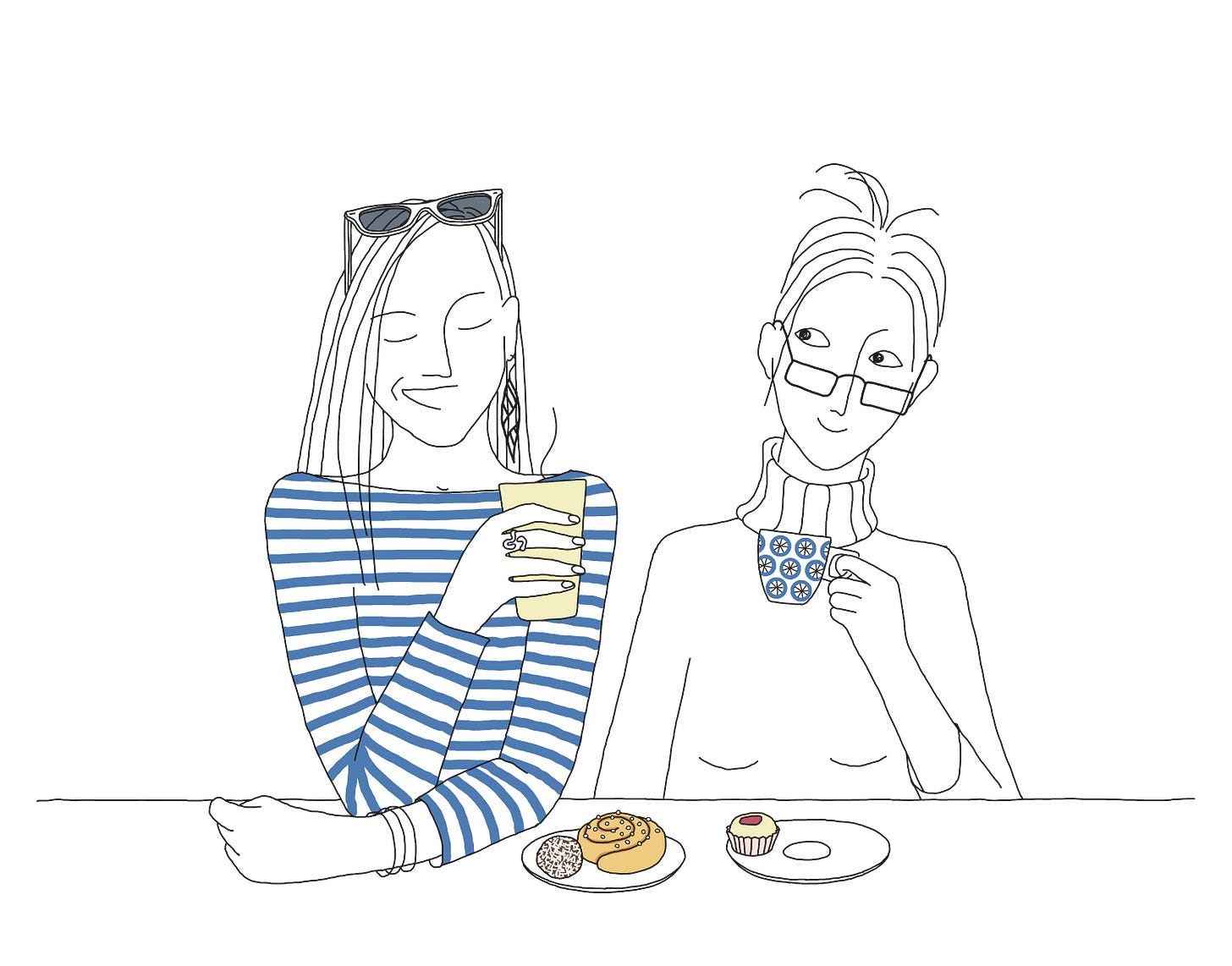
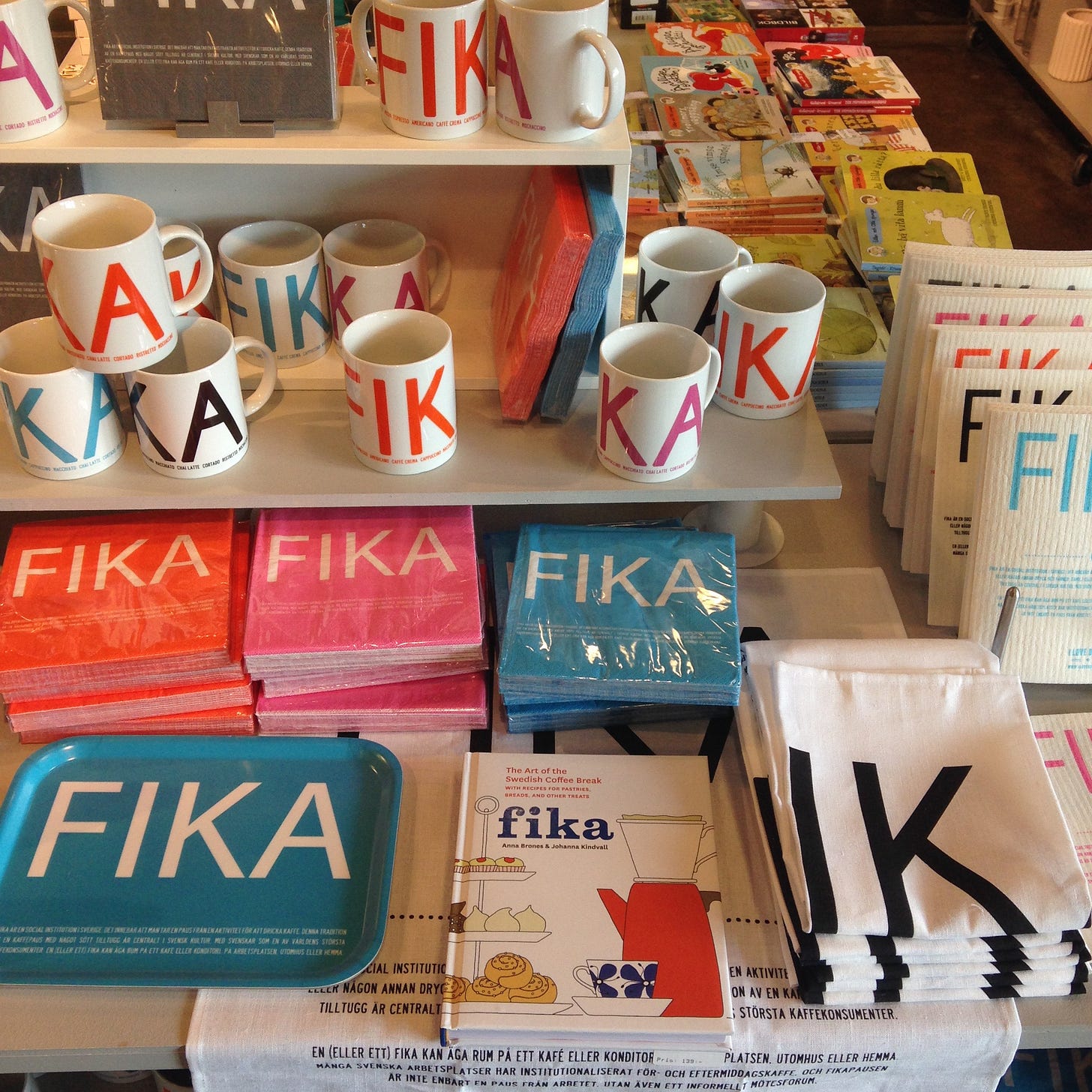
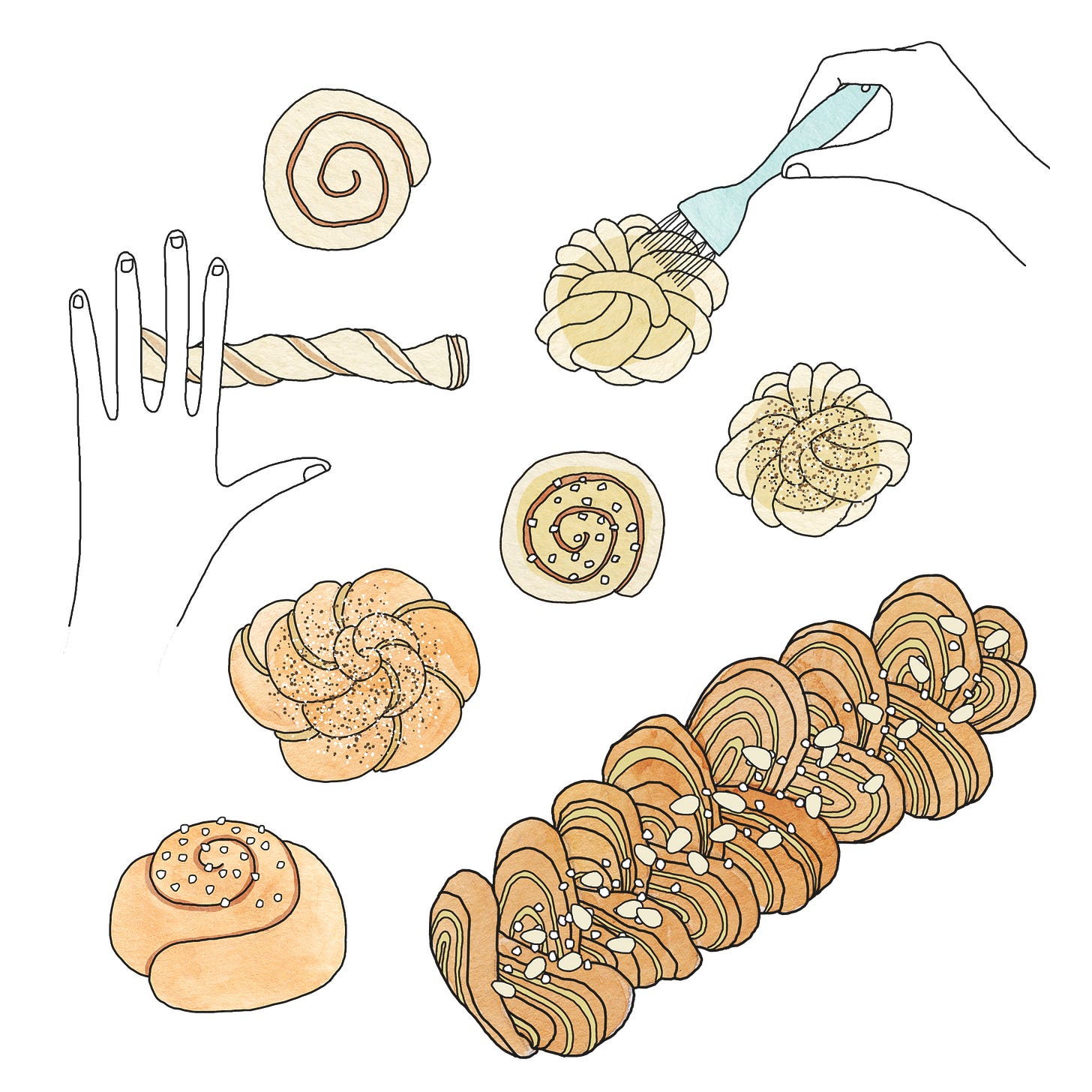
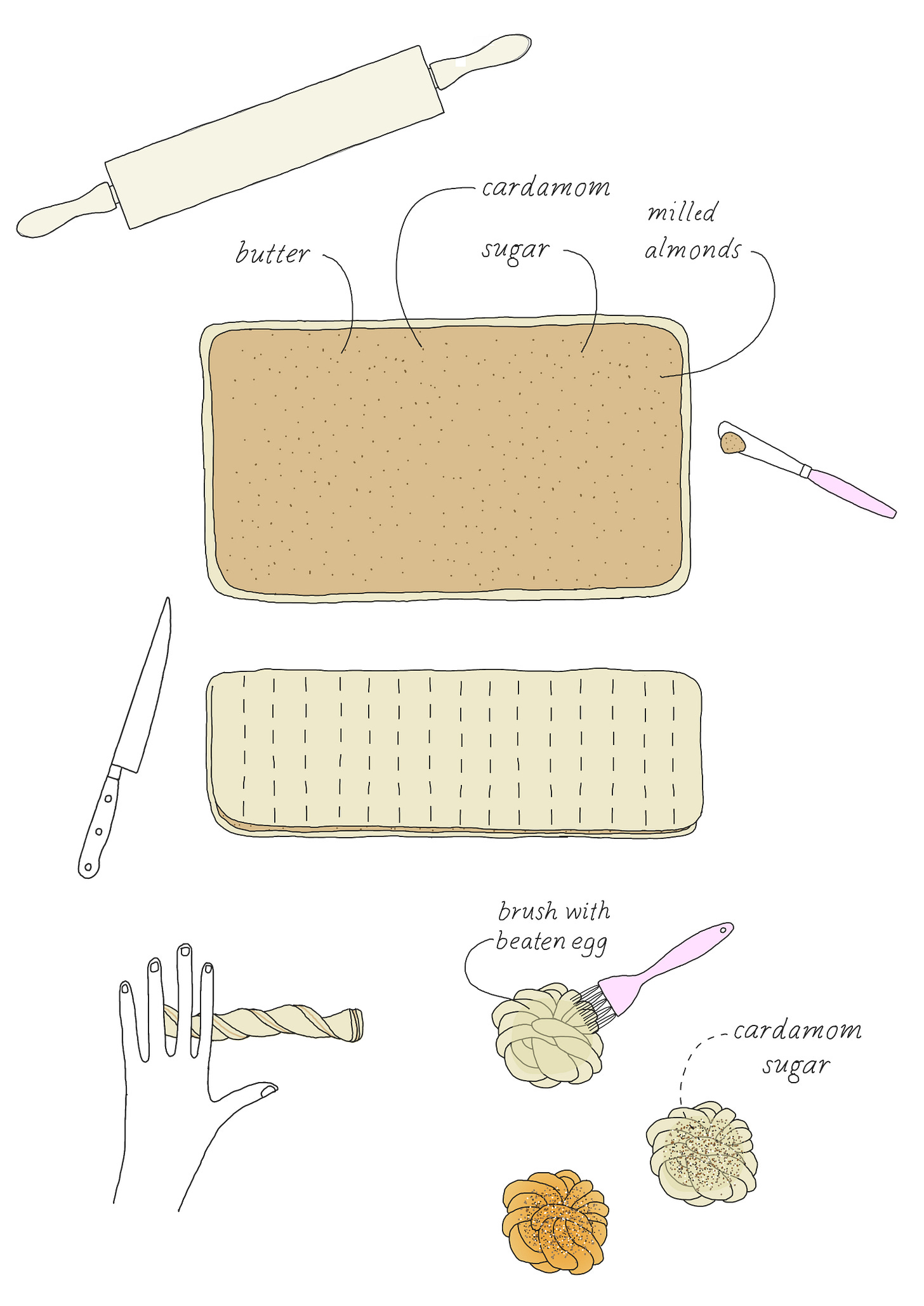
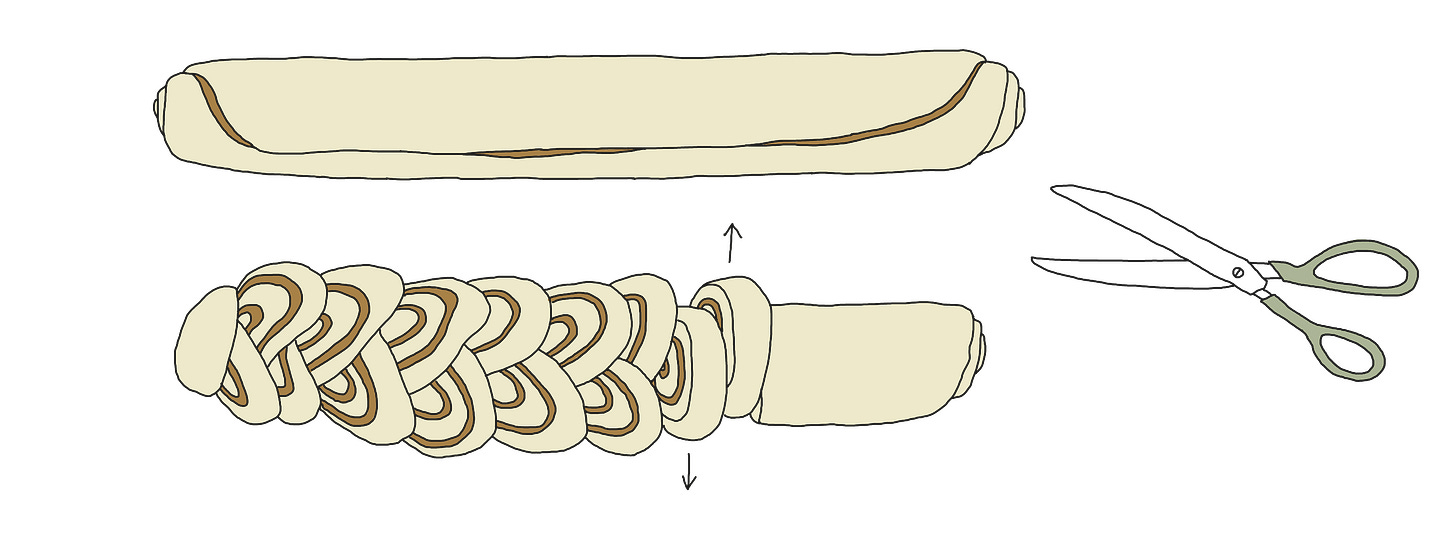


It’s my go-to recipe book for sure, my friends have had kladdkakka at every potluck for a decade and they’re not sorry!!
Congratulations on ten years! It is such a terrific book. My copy is packed or I’d be pulling it out to bake from today, in your honor!